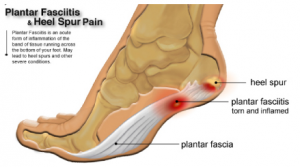If tend to experience stabbing pain in the heel of your foot the minute you step out of bed, chances are that you’ve developed a common foot condition that affects almost two million Canadians every year: Plantar Fasciitis. This condition entails pain and inflammation of the plantar fascia, which is a thick band of tissue that runs across the bottom of your foot to connect the heel bone and your toes. While it’s common in runners, it can also affect individuals who are overweight, have high arches or flat feed, suffer from tight Achilles tendons or calf muscles, or wear shoes with inadequate support.
Symptoms of Plantar Fasciitis
Plantar fasciitis is usually self-diagnosable, making lab tests or imaging unnecessary at times. Basically, the condition is identified by pain in the underside of the heel. Traditionally, one spot is the main source of pain, often 4 cm forward from the heel. If you touch that area, you’ll notice that it’s tender to touch. Moreover, the pain will be worst when you take your first steps getting up in the morning or after long periods of sitting. However, the pain is temporary and may disappear once you start walking more or after you’ve rested.
Other rare symptoms include radiating pain, numbness, tingling, or swelling. You’ll need to head to your doctor after these or else risk rupturing your plantar fascia. If you’ve already been experiencing plantar fasciitis pain for some time, make sure that you’re not experiencing signs of plantar fascia rupture, which are clicking or snapping sounds as you walk, significant swelling, and acute pain in the sole of your foot.
How to Treat Plantar Fasciitis
The pain of plantar fascia usually disappears albeit slowly. Like ligament issues, this condition will take a few months before you can breathe easily. However, you can use the following initial treatments (a.k.a. conservative treatments) for this condition.
Rest Your Foot – Avoid running or excess walking and standing. You should also avoid stretching your sole to prevent the pain from recurring.
Wear the Right Shoes – Opt for orthopedic shoes with cushioned heels and ample arch support. If you can, wear laced sport shoes rather than open sandals. Whatever you do, avoid old or worn out shoes as these are the main cause of your pain.
Get Heel Pads or Custom Orthotics – There are numerous pads and shoe inserts that you can get to support the arch of your foot. It’s best to have one custom made to your foot
Ask for Painkillers – Your pedorthist may prescribe a few painkillers such as paracetamol to ease the pain. You may also need to take anti-inflammatory medicines such as ibuprofen or rub cream/gel onto your heel.
Stretch Your Heels with Gentle Exercises – Your doctor may refer you to a physiotherapist to learn a few exercises that loosen the tendons and fascia above and below your heels. Most exercises entail sitting on a chair or on the floor and holding certain positions for 30 seconds.
In case these treatments don’t work out or produce results quickly, you’ll need to consider other treatments as well. Your physician may recommend steroid injections to relieve the pain, but they won’t cure the problem and can put you at the risk of tearing the plantar fascia. You may also undergo extracorporeal shock wave therapy, which entails delivering high-energy sound waves through the skin to stimulate the healing of your plantar fascia. Finally, surgery can be a good option for difficult cases. However, you should talk to your doctor before taking this step.
Instead of bearing with the pain of plantar fasciitis or spending too much on treatments, consider preventing this condition by regularly changing your training shoes, wearing footwear with good cushioning and arch support, losing weight, regularly stretching before exercise, and avoiding exercise on hard surfaces.
Better yet, contact Dr. Raj Mann, the qualified Canadian pedorthist with experience in orthotic manufacturing and dispensing. Combining his 13 years of experience with extensive knowledge, he offers his services through Pedorthic Works. Click here to book an appointment with Dr. Mann today.

